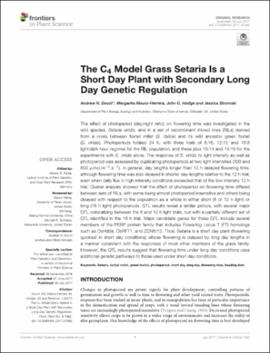| dc.contributor.author | Doust, Andrew N. | |
| dc.contributor.author | Mauro-Herrera, Margarita | |
| dc.contributor.author | Hodge, John G. | |
| dc.contributor.author | Stromski, Jessica | |
| dc.date.accessioned | 2019-09-25T18:24:48Z | |
| dc.date.available | 2019-09-25T18:24:48Z | |
| dc.date.issued | 2017-07-06 | |
| dc.identifier | oksd_doust_thec4modelgrass_2017 | |
| dc.identifier.citation | Doust, A. N., Mauro-Herrera, M., Hodge, J. G., & Stromski, J. (2017). The C4 model grass Setaria is a short day plant with secondary long day genetic regulation. Frontiers in Plant Science, 8. https://doi.org/10.3389/fpls.2017.01062 | |
| dc.identifier.uri | https://hdl.handle.net/11244/321455 | |
| dc.description.abstract | The effect of photoperiod (day:night ratio) on flowering time was investigated in the wild species, Setaria viridis, and in a set of recombinant inbred lines (RILs) derived from a cross between foxtail millet (S. italica) and its wild ancestor green foxtail (S. viridis). Photoperiods totaled 24 h, with three trials of 8:16, 12:12 and 16:8 light:dark hour regimes for the RIL population, and these plus 10:14 and 14:10 for the experiments with S. viridis alone. The response of S. viridis to light intensity as well as photoperiod was assessed by duplicating photoperiods at two light intensities (300 and 600 μmol.m-2.s-1). In general, day lengths longer than 12 h delayed flowering time, although flowering time was also delayed in shorter day-lengths relative to the 12 h trial, even when daily flux in high intensity conditions exceeded that of the low intensity 12 h trial. Cluster analysis showed that the effect of photoperiod on flowering time differed between sets of RILs, with some being almost photoperiod insensitive and others being delayed with respect to the population as a whole in either short (8 or 12 h light) or long (16 h light) photoperiods. QTL results reveal a similar picture, with several major QTL colocalizing between the 8 and 12 h light trials, but with a partially different set of QTL identified in the 16 h trial. Major candidate genes for these QTL include several members of the PEBP protein family that includes Flowering Locus T (FT) homologs such as OsHd3a, OsRFT1, and ZCN8/12. Thus, Setaria is a short day plant (flowering quickest in short day conditions) whose flowering is delayed by long day lengths in a manner consistent with the responses of most other members of the grass family. However, the QTL results suggest that flowering time under long day conditions uses additional genetic pathways to those used under short day conditions. | |
| dc.format | application/pdf | |
| dc.language | en_US | |
| dc.publisher | Frontiers Media | |
| dc.rights | This material has been previously published. In the Oklahoma State University Library's institutional repository this version is made available through the open access principles and the terms of agreement/consent between the author(s) and the publisher. The permission policy on the use, reproduction or distribution of the material falls under fair use for educational, scholarship, and research purposes. Contact Digital Resources and Discovery Services at lib-dls@okstate.edu or 405-744-9161 for further information. | |
| dc.title | C4 model grass Setaria is a short day plant with secondary long day genetic regulation | |
| osu.filename | oksd_doust_thec4modelgrass_2017.pdf | |
| dc.description.peerreview | Peer reviewed | |
| dc.identifier.doi | 10.3389/fpls.2017.01062 | |
| dc.description.department | Plant Biology, Ecology and Evolution | |
| dc.type.genre | Article | |
| dc.type.material | Text | |
| dc.subject.keywords | setaria | |
| dc.subject.keywords | foxtail millet | |
| dc.subject.keywords | green foxtail | |
| dc.subject.keywords | photoperiod | |
| dc.subject.keywords | flowering time | |
| dc.subject.keywords | heading date | |
| dc.subject.keywords | short day | |
| dc.subject.keywords | long day | |
